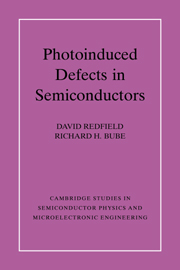Book contents
- Frontmatter
- Contents
- Preface
- 1 Introduction: Metastable Defects
- 2 III–V Compounds: DX and EL2 Centers
- 3 Other Crystalline Materials
- 4 Hydrogenated Amorphous Silicon: Properties of Defects
- 5 Hydrogenated Amorphous Silicon: Photoinduced Defect Kinetics and Processes
- 6 Other Amorphous Semiconductors
- 7 Photoinduced Defects in Devices
- References
- Index
2 - III–V Compounds: DX and EL2 Centers
Published online by Cambridge University Press: 15 December 2009
- Frontmatter
- Contents
- Preface
- 1 Introduction: Metastable Defects
- 2 III–V Compounds: DX and EL2 Centers
- 3 Other Crystalline Materials
- 4 Hydrogenated Amorphous Silicon: Properties of Defects
- 5 Hydrogenated Amorphous Silicon: Photoinduced Defect Kinetics and Processes
- 6 Other Amorphous Semiconductors
- 7 Photoinduced Defects in Devices
- References
- Index
Summary
Introduction
Among defects in semiconductors the DX center is unique in the extent and detail of its studies and in the advanced present state of its understanding. It (or similar centers) has been observed in n-type III–V compounds doped with a variety of species of atoms and in some II–VI compounds; it may also be related to the dominant defect in a-Si:H. The donor-related DX center in AlGaAs alloys (the most widely studied) can thus serve as a model that can usefully be invoked in the study of other semiconductor defects; the EL2 defect in GaAs – a native defect in undoped material now thought to be an AsGa antisite defect (an As atom on a site that normally would have a Ga atom) – has some similar properties, and is discussed in Section 2.6. We show later in this chapter that this model provides a new and convincing explanation for a major limitation on the ability to dope some III–V materials. This limitation has caused even more serious impediments to the applications of II–VI materials, and (as discussed in Chapter 3) the DX model is useful there too. Present understandings followed nearly twenty-five years of efforts to elucidate metastability in III–V compounds, and the literature is large; we therefore present here only a brief summary of the early work, which is described well in reviews by Lang (1992), Langer (1980), and Mooney (1990, 1991), who also discussed the impacts of such deep donors on the properties of devices using these materials.
A number of observations of anomalous effects have been reported for these centers, with the consequent conclusion that the familiar one-electron picture of deep-level centers is inadequate.
- Type
- Chapter
- Information
- Photo-induced Defects in Semiconductors , pp. 24 - 49Publisher: Cambridge University PressPrint publication year: 1996



